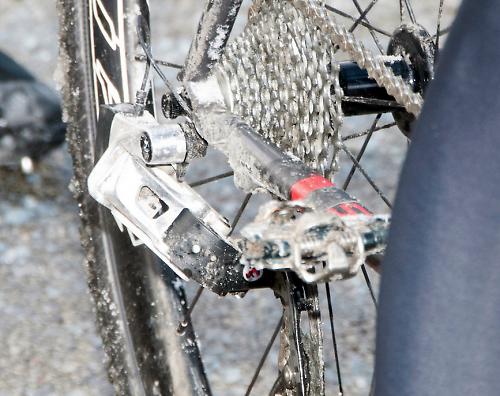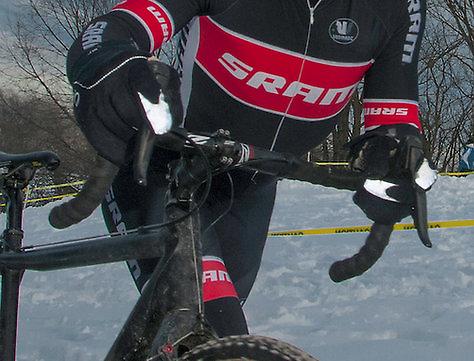- News
- Reviews
- Bikes
- Accessories
- Accessories - misc
- Computer mounts
- Bags
- Bar ends
- Bike bags & cases
- Bottle cages
- Bottles
- Cameras
- Car racks
- Child seats
- Computers
- Glasses
- GPS units
- Helmets
- Lights - front
- Lights - rear
- Lights - sets
- Locks
- Mirrors
- Mudguards
- Racks
- Pumps & CO2 inflators
- Puncture kits
- Reflectives
- Smart watches
- Stands and racks
- Trailers
- Clothing
- Components
- Bar tape & grips
- Bottom brackets
- Brake & gear cables
- Brake & STI levers
- Brake pads & spares
- Brakes
- Cassettes & freewheels
- Chains
- Chainsets & chainrings
- Derailleurs - front
- Derailleurs - rear
- Forks
- Gear levers & shifters
- Groupsets
- Handlebars & extensions
- Headsets
- Hubs
- Inner tubes
- Pedals
- Quick releases & skewers
- Saddles
- Seatposts
- Stems
- Wheels
- Tyres
- Health, fitness and nutrition
- Tools and workshop
- Miscellaneous
- Cross country mountain bikes
- Tubeless valves
- Buyers Guides
- Features
- Forum
- Recommends
- Podcast
TECH NEWS
More photos of SRAM’s new electronic groupset
Last week photos taken by photographer Von R Buzard at a US cyclo-cross race confirmed that SRAM is currently developing an electronic groupset. SRAM clearly isn’t fazed by the publicity, as the same chap, most likely a SRAM employee, has been out testing the new groupset again, and Von has sent us over these photos.

The photos give us a bit more of a clue as to how the groupset might look, but there isn't any information forthcoming from the company so we can only speculate. We can only guess at what stage in the development cycle the groupset is, but from the reasonable level of finish we reckon it must be pretty close to ready. SRAM has a habit of using cyclo-cross riders to test its latest kit, it was in similar races that its hydraulic disc brakes were first spotted in the wild.

What can we speculate then? Well, it looks like the derailleur has a motor mechanism bolted to the rear, with the wire protruding from the top and snaking away into the frame, much like Shimano’s Di2 groupset. Looking closer reveals the P-knuckle of the mech (at the end of the parallelogram) appears very different from a regular SRAM Red derailleur, so we wonder if that is the motor and the black housing contains the brains. The rest of it looks much the same as a regular SRAM Red derailleur.

This photo shows us a reasonably clear glimpse at how the front derailleur looks, with the motor and protruding wire atop the mechanism. What looks likely to be the brains of the groupset, or equally the battery, is mounted on top of the stem. Well, taped to the stem is more accurate. If it’s a battery it does look on the small side compared to the size of battery featured on Shimano Di2 and Campagnolo EPS groupsets, but SRAM could be using a small battery purely for testing purposes. Equally, SRAM might be looking to keep the weight of the groupset as low as possible, and a small battery is one easy way to shed a load of mass. And if they've shrunken the battery, they could fit the brains of the groupset into the same small box. That makes packaging the groupset on a bike far easier than both Shimano and Campagolo currently.

Also showing a bit more clearly, though not enough to make any detailed observations, are the new shifters. There’s been some speculation as to how they might adapt DoubleTap on an electronic groupset, even if it’s possible at all. From this photo it does look like DoubleTap, with the telltale single lever behind the brake lever. Would SRAM develop a new shifting system for electronic? From this photo it doesn’t look like it.
That's our speculation based on a couple of blurry photos anyway. We're sure more details will emerge soon.
David worked on the road.cc tech team from 2012-2020. Previously he was editor of Bikemagic.com and before that staff writer at RCUK. He's a seasoned cyclist of all disciplines, from road to mountain biking, touring to cyclo-cross, he only wishes he had time to ride them all. He's mildly competitive, though he'll never admit it, and is a frequent road racer but is too lazy to do really well. He currently resides in the Cotswolds, and you can now find him over on his own YouTube channel David Arthur - Just Ride Bikes.
Latest Comments
- ChrisA 6 hours 46 min ago
An illegal moped (obviously no tax/insurance) with a flat battery is, functionally, a pedal cycle. An illegal (for whatever reason, & say no...
- brooksby 7 hours 13 min ago
Are sales low because it seems like every other bike retailer is closing? So sales are low because people can't buy bikes (rather than because they...
- AidanR 7 hours 19 min ago
I don't recommend watching the video (!). ...
- Rendel Harris 8 hours 13 min ago
I generally get a response saying that action will be taken in 90% of cases I submit (I do only submit ones that I believe are absolute certanties)...
- OldSkoolOldFart 8 hours 31 min ago
If you can't hear me call out a cheery (loud) "excuse me" as I approach them you're not going to hear the pathetic "ting" from a tiny bell....
- Spangly Shiny 9 hours 5 min ago
I got mine FOC with a Galibier gilet, just as versatile as a Buff.
- Spangly Shiny 9 hours 24 min ago
From the outside the US appears to be a Christian fundamentalist country, with the same prudish outlook as other religious fundamentalist countries.
- Simon E 10 hours 3 min ago
It's bullshit, a token effort akin to sportswashing....
- Rendel Harris 10 hours 9 min ago
If you know anyone with Zwift or other indoor training programmes, they all have FTP tests on them so you wouldn't have to subject yourself to a...





Add new comment
29 comments
They could indeed. Use wired/mechanical while your opponents use wireless and then have someone jam the signals. Viola, you win the sprint...
Couldn't competitions be subjected to electronic sabotage if someone decided to interfere with the signals?
I do wonder if wireless is the way to go. After all that technology has moved on so much from the old Mavic days.
Can't see me going electric yet as the mechs are too pricey to be damaging but if SRAM did manage to get the size down it would sway me towards them. Modern Shimano and Campag electric ones are so bloody ugly.
finally I have always wondered why battery life is a big issue. We charge everything else in our life so what would be wrong a battery that did say a thousand miles of over shifting before it needs changing?
Mavic tried electronic wireless shifting in the 90s with the Mektronic. Catastrophe, never worked properly. You can read elsewhere about the problems with it.
How much testing do you do, the best testing is when the public who expect a cycle to go for ever get hold of it. As things like this new technology come out the "Amish" style (loving that quote above) will remain the endurance superior kit. Can you imaging cycling around the world with Di2, EPS or SRAMs offering.
The sequential shifting sounds like a cool idea, but not sure in practice it'll be all that good, as the extra delay in shifting as you move between rings would be a bit disconcerting if you didn't know if it was going to happen or not, especially if you're on the limit.
Another cool thing you could do is link the Di2 to your cadence meter, programme in min and max cadences, and then let it shift up or down for you - basically like riding an automatic. With a speed and gradient meter could even set different cadences for sprinting, climbing, etc. Again, a cool idea in terms of 'what can you do with technology', but most probably a bit disconcerting to actually try and ride with!
Surely I can't be the only cynic who finds it a little suspicious SRAM leak these pictures to the media just when they anounce a third product recall for their flagship groupset? Seems a great way to divert the unwelcome attention!
I will wait until they introduce a red electronic with hydraulic disc brakes so I all the product recalls at once.
Let's all hope it works more reliably than their hydraulic brakes
It's a bit academic thanks to my overdraft but I'm staying Amish when it comes to gears on my bikes.
It somehow seems to run contrary to the essential simplicity and mechanical-ness of bicycles to have electronics on bikes as an integral part of their function. Look at computers and iphones and the like - few of their users truly understand how they work and why they stop working but bicycles, despite all the carbon and titanium and technology are fundamentally simple to understand how they work - products of mechanical engineers, not software coders.
I think we risk losing something very essential if electronics take over.
Yeah not sure much point in wireless, only be a fad really.
Assuming a central battery you need cables to both derailliers so you're only talking about saving cables from the shifters, which would then need their own batteries if the central one wasn't there. No I think that running the signal on the same 2 core power leads is the most likely way.
Plus I'm sure I speak for most cyclists when I say I dont want a computer selecting what ring I'm in. The computer cannot see the upcoming undulations or gradients, nor does it know how much power you've got left!
Some of us like to select the big ring or little ring depending on how we want to ride a particular section, so no way thats a piss poor idea IMO.
I think you've misunderstood. It doesn't matter whether you're in the big ring or little ring, it's the gear ratio that matters. The computer would just calculate whether your next gear would require the big or little ring in conjuction with the next sprockett.
It's not the computer deciding what gear you should be riding. True sequential gears would be epic.
electronic shifting is very good, but i'd rather be in control of which ring i'm in, rather than have the system boot me up or down at a preselected point. also, to be properly sequential the system would need to shift both ends at the same time at the point where you change rings, which could lead to issues. I'm just not sure it'd be a big improvement.
I'm not convinced that wireless is really a possibility right now, because of battery life. Di2 and EPS are good for 1,000km between charges. Make it wireless and you'd be looking at a battery life of days, at most. Even on low-power bluetooth.
Wow, they are actually TESTING a product!
Is there any reason why these electronic shifters need two sets of buttons? (i.e. one for the front and one for the back).
It seems to be that you only need to change to the next gear up, (or down) and so you could let the electronics decide which front ring you need to be on, and which cog at the back, to give you the next gear ratio available. You'd only need two buttons then for the whole system.
(or is that how they do work, I've not really looked at them!)
no, it's not how they work. interesting idea though, i know it's one that has been looked at before. i had a twist shifter that did the same thing mechanically a while back...
SRAM are using the doubletap levers, but they are going sequential for shifting. Left hand level goes up, right down. That is how the differentiate themselves from Shimano and Campagnolo.
The other thing I've heard that might fit in with the pictures, its actually wireless for transmitting the signal and the wire is for battery only.
there's only 2 paddles with doubletap though, so how to do sequential shifting front and rear?
incidentally, you can set up Di2 to shift sequentially if you want. you just reprogram the buttons. Chipps from Singletrack uses it like that.
I think you misunderstood my meaning of sequential. I mean sequentially through your 22/20 gears hitting all the ratios in sequence. You only need up and down in that case as you aren't choosing to shift to the big/small ring or where on the cassette to good.
Current Di2 lets you program one side does up, the other side does down for both the front and the rear, but it doesn't offer true sequential shifting. So far only the Fairwheel project bike has managed that
http://www.cyclingnews.com/features/fairwheel-bikes-creates-stunning-seq...
That could work with 1x11, and would probably be ideal for cyclo-cross. Bit tricky to do that with a double chainset though.
If it really was wireless, it would be sort of pointless wouldn't it if you then have to trail wires through the frame to the stem mounted battery, you might as well use the wires to transmit the signals like Shimano and Campagnolo do?
See my explanation above about sequential shifting. With regard to wireless you are thinking based on current implementations. Who says there has to be one battery. Most of the power is needed by the motors, not the shifters.
Up front you have the shifters connected to a smaller battery/head unit that communicates wirelessly with the derailleurs at the back that are connected by one wire and a battery possibly integrated into them as well. You have removed a lot the installation issues with fishing about with internal wiring and cable ties.
i think you're underestimating the amount of battery capacity you need to maintain a constant wireless connection between the components. much, much more than the motors, which only work very periodically, require.
Are you thinking in terms of WiFi? Ant+ doesn't seem to be a huge drain on the sensor batteries and they have to send a signal for more often than a shifter, but even then we are talking about transmitting a signal through the air. Wires could conceivably be replaced with conductive tape or by having a separate battery at the shifters and the derailleurs one could potentially transmit a signal directly through the frame material, hence "wireless" with less power requirements. If this happens remember it was my idea.
transmitters never require much power, because they don't have to be constantly on. receivers do, however.
conductive tape is an interesting idea. what i reckon will happen eventually is that the wire loom, in whatever form it takes, will just be built into the frame. fairly simple with carbon
But there is no need for a constant wireless connection. A signal only needs to be sent when a shift is needed.
I think that the risk of the signal being jammed and the lack of an actual advantage (given the need for wires from a central battery or multiple batteries) is a better reason why this is a non-starter.
unless the system is constantly listening for that shift, it won't happen. so there needs to be something constantly using battery power, listening for a shift.
Not true. The receiver can wake up several times per second and listen for a few milliseconds and then go to sleep again. When the system wakes up often enough, you won't notice the lag. ANT and Zigbee protocols are built for applications like this, where low power use is important, but transmission speed can be low:
http://www.eetimes.com/document.asp?doc_id=1274011&print=yes
In principle, you can lower the wake up time even more when the bike is in the shed or eliminate it altogether. Perhaps with a motion sensor that shuts down the receiver when no motion happened for 5 minutes.
Indeed. I don't think battery power is the issue with bluetooth / ant/ zigbee et al.
However it's pretty simple to produce a 2.4gig RF transmitter to jam the signals*, which would strike me as a major flaw in a competition environment.
The screened single wire used by Shimano is going to be really hard to jam with an RF pulse.
On the power front, Shimano recently lodged a rather neat patent that consisted of a micro dynamo built into the lower jockey wheel to charge the system battery.
*When I say simple, it's probably not really really really simple, as all these low power rf systems channel hop. But it's not beyond the wit of manto block all the channels. That said something really crude and nasty such as a spark generator may produce sufficient broadband RF energy to block the signal.